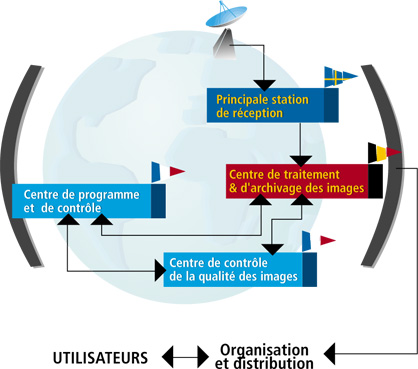The Vegetation system will enable continuous, regional and global monitoring of the
continental biosphere and crops.

The system's space segment, a payload on SPOT 4, offers a
swath width of about 2 250 km (twice the width of France). This achievement is due to a
combination of a wide field of view (101°) and the SPOT 4 orbit.
About 90% of the globe is covered daily and the remainder the following day. The
spectral band high resolution in visible and infrared,
have been specially designed to monitor plant cover. Since the Vegetation and HRVIR
payloads use the same spectral bands, the two are highly complementary.
The Vegetation ground segment includes components for programming imaging, receiving
and processing imagery and distributing standard image products. These are:
- the CNES control and command facilities for SPOT 4 which
generate and upload the daily activities programme (image
acquisiton and recording) and monitor operation of the Vegetation payload,
- a main
station for X-band reception at Kiruna in Sweden, which receives all global data
recorded on the satellite then inventories and archives them
- an image quality centre, at
the CNES site in Toulouse, close to the SPOT imagery processing centre, which monitors
image quality and defines image processing parameters,
- an image
processing centre at Mol in Belgium which processes the imagery received by the main
station and distributes standard products to users,
- a reference regional
receiving station in Toulouse for demonstrating the potential for L-band reception.
Scientists will thus be able to take advantage of reception compatibility with other
sensors, such as the American AVHRR, which transmits in the same frequency band.
top of page, article

page updated on the 00-06-06
 The Vegetation system
The Vegetation system The Vegetation system
The Vegetation system
![]()